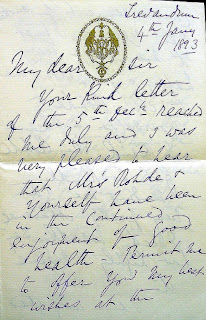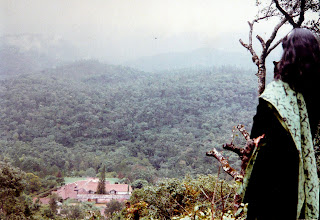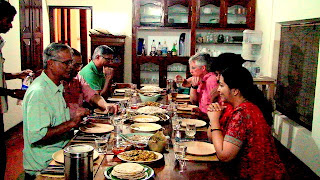Some Royal Correspondence


Old letters are very interesting to read. Those were often very warm, personal and written with much integrity. In the present era of emails, personal letters are becoming rarer and in the emails you miss the personal warmth and sometimes the sincerity of purpose.
Letters from Royalty and men of authority are a class by themselves. It also rewinds history. It can be very amusing, informative and thrilling to go through such letters.
I have with me this original handwritten and signed letter of Maharaja Moolam Thirunaal Ramavarma of Travancore (who reigned between 1885 and 1924) dated 4th January 1893 and addressed to one John Rhode of the erstwhile Travancore Civil Service.
The Maharaja’s handwriting is very clear and the language is beautiful, to say the least. It is reproduced below:
Trivandrum, 4th January 1893
My dear Sir,
Your kind letter of the 5th December reached me duly and I was very pleased to hear that Mrs. Rhode and yourself have been in the continued enjoyment of good health. Permit me to offer you my best wishes at the commencement of another new year. I trust it may be a very happy and prosperous one to MRS. Rhode and yourself. I have to thank Mrs. Rhode for so kindly sending me the very pretty Almanac. I need hardly say how highly I value it.
I am very glad to hear you have been enjoying your stay in England and sincerely hope that you will be greatly benefited by the change.
H.E. the Governor’s visit went off very well. The weather was very bad on the Hills where H.E. and party were there. Still everything passed off satisfactorily and H.E. was able to shoot a tusker.
Mr. Hannyngton retired soon after H.E’s visit was over and you might of course have heard that Mr. Grigg has succeeded him.
I am sorry to learn from your letter that Mrs. Rhode will not be returning to India with you. I suppose you intend staying at home the whole of your furlough.
Mr. and Mrs. Hannyngton are still at Bolghatty. Mr. Hannyngton was appointed to settle some long pending boundary dispute between Cochin and the British Government and this work has occupied him all this time. I believe they will be going home only after the winter is over.
I am thinking of paying a visit to HE Lord Wenlock about the end of this month and will be away from Trivandrum for about a month. With kindest regards and again thanking you for your good wishes,
I remain
Yours very sincerely
Rama Varma
· Mr.Rhode who was in the Travancore Civil Service obviously had been to England for holidays when this letter was written. I got possession of this letter from London.
My little and amateur work after the names mentioned in the letter reveal some interesting details of the people.
· The mention of H.E. the Governor refers to Beilby Lawley, 3rd Baron Wenlock (1849-1912) the Governor of Madras for the years 1891-95.
He was educated at Eton College and at Cambridge University and was commissioned into the Yorkshire Hussars in 1869. He was also the Member of Parliament for Chester in 1880, and Governor of Madras 1891–1895. Wenlock was appointed a Privy Counsellor in 1901, and made a Lord of the Bedchamber to George, Prince of Wales.
The work on the Nilgiri Railway Company in Ooty line was started in August 1891 by Lord Wenlock. In 1895, he also laid the foundation stone of the Summit Hall of the Kodaikanal Observatory, which boasts of one of the world's oldest extant telescopes.
The maharaja mentions in his letter that “H.E .was able to shoot a tusker.”In those Raj days, hunting was an essential pastime when the Viceroy or the Governor visited the princely states. These were done with much opulence and fanfare and detailed arrangements.It may be ironic that the nephew of this Governor, and the son of Sir Arthur and the Governor of Madras during 1906-11, died accidentally in another hunting expedition thus blighting considerably, the enthusiasm of the family for hunting.
19th Century Flag of Travancore.
Raja Sir Vira Kerala Varma - 1888 - 1895 (Chingamasathil theepeta Maharaja) was the ruler of Cochin during this period. He had played a prominent part as Elaya Raja and he was knighted by the British, even before the installation. He was well educated, well intentioned and amiable. His address during the installation was follows:
"Gentlemen, It has been the Will of Providence that the important and difficult task of ruling this ancient State should now, devolve on me by the sad and premature demise of my beloved and revered brother. Though I am a novice in the art of governing just now, and therefore cannot any promise of success, I can assure you that , with the kind and valuable advice of Mr Hannyngton as the British Representative at our Court and as a sincere and intimate friend of mine having the prosperity of the State always at heart, and with the support and protection of the Government, I shall try my utmost to perform the responsible and the sacred duty of promoting the welfare of my subjects to the best of my ability, by endeavouring , though difficult, to follow the footsteps of my late lamented brother."
Dewan T. Govinda Menon, the capable Dewan under the former Raja, retired after a year following the above installation. Dewan Govinda Menon had established the Raja's Court of Appeal and it was during his tenure that the outstanding boundary disputes between Cochin and Travancore were resolved, in which Mr. Hannyngton also played a significant part.
Was it not interesting to go through a bit of history from the details of this letter?






Comments
What a fascinating post about the Royal Correspondence and the Maharaja of Travancore.
I can give you a little more detail on John Rohde (note spelling), the addressee of the Maharaja's letter, because he was my great-great uncle.
Like most of his family was born in India, son of an East India Company civil servant who had been through the Company's college at Haileybury, and finished up as Inspector-General of Jails.
The John Rohde of the letter (usually nicknamed Jack) was the Commercial Agent to the Maharaja. He had recently taken over from his father-in-law, Hugh Crawford, my great-great grandfather, who had seemingly left under a cloud.
About 1900 Jack Rohde retired to England with his wife Isabella. They lived in a large house near Reigate, called Cranham Lodge. They had two children.
The son, called John like his father and grandfather, was a career officer in the Royal Engineers. He was reported missing in France on 28 Oct 1914, a few weeks after the start of World War One. Nothing was known about his death, although his father put adverts in the papers appealing for information.
Jack and Isabella's daughter Eleanor Sinclair Rohde became a great expert on gardens and the history of gardening, notably the uses of plants and herbs. She wrote many books on the subject and used to give talks and broadcasts. She was one of the first regular speakers on the BBC, from 1925 onwards.
I wonder how you managed to find this letter. Do you have any more? I'd love to know more about Jack Rohde, especially his time working in Travancore.
Congratulations again on such an interesting post.
Best wishes.
Robert
Thank you indeed for the kind words and for your response giving a lot of information about Jack, which I value greatly.
I am also delighted that the mail is from the great grand nephew of John Rohde. (The correct spelling is noted. Having been in Africa for some time and with all my reading about Cecil Rhodes, I spelled the name wrong about which I am sincerely sorry.)
The much needed information given by you shall be properly recorded. I feel sincerely for John and can understand the agony which Jack and Isabella went through. I am glad to note that Rohde, Eleanor Sinclair (1883-1950), of Reigate was a gardener of repute and that she was a prolific writer. She has written, I have now noted, many old English Gardening books. I hope to procure some from some antique book shops of England, which I know.
I got the referred letter from London, from an expert in manuscripts etc. I have this passion for the British Raj period and my hobby is collecting British war medals. I do collect manuscripts and am having a small collection. As you may have noticed, my surname is Varma. We are connected to the Travancore and Cochin Royal families, though distantly.
Now that I know Jack was the Commercial Agent to the Maharajah, I shall work on and try to get the maximum information on him probably from the Royal household through my contacts. I shall not fail to pass on the information to you. Will you kindly send me your email address? Are you stationed in London?? In the last couple of years, I have visited England, thrice.
Once again let me thank you profusely for the kind post without which I would have been poorer in my knowledge about Jack.
Please be in touch.
Kindest regards,
Murali
I forgot to mention about Hugh Crawford, your great great grandfather. Am I to understand that Jack took over from him as Commercial Agent?
I hail from the District of Alleppey , a port town of erstwhile Travancore.
The beach at Alleppey is one of the most popular tourist spots. A 1000 ft long pier was built at this Alleppey beach by Captain Hugh Crawford in 1862. An old lighthouse also continues to attract visitors to this beach.Could this Captain Hugh Crawford be your great great grandpa?
regards,
The Times | September 15, 1880
Marriages:
On the 12th August at Alleppey, by the Right Rev the Bishop of Travancore, John Rohde to Isabella Brownlie Reynolds daughter of Hugh Crawford Esq.
Acting Judge of Small Cause Court, Tellicherry. 1867: Sub-Collector, Bellary; Acting Collector and Magistrate,Malabar; Judge of Small Cause Court, Tellichery. 1868 : Acting Civil and Sessions Judge, Tellicherry; afterwards at Calicut. 1869
Kind regards,
Sincerely, Ram
Kind regards,